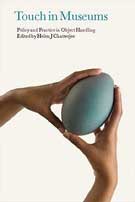review by Adam Blackshaw

I told you homeboy
You can't touch this
MC Hammer, 'U can't touch this', 1990
Try to touch objects on display in a museum and see what happens. If you don't stub your fingers on the protective glass of the display case, you're likely to set off an alarm or become acquainted with a friendly security guard. For the most part this is just as well. Objects in museums are often precious and excessive handling will hasten their deterioration. Just ask anyone in the conservation section about the oils and acids that are found on the human hand. But why is touch, our most intimate and immediate human sense, so often neglected in our public institutions? Why is sight, in the Western world at least, so heavily privileged over the other senses? Why do we seem to have wholly succumbed to a kind of ocular hegemony? What experiences and learning opportunities are lost when we refuse to allow people to make physical contact with objects in museums? Or, to turn the question around, what learning opportunities are created if a museum's interpretation strategy encourages the physical handling of objects?
The chapters presented in Touch in Museums are the result of a number of workshops held in the United Kingdom in 2006 and 2007. These workshops were aimed at establishing a more thorough understanding of the benefits to be gained from providing opportunities for museum visitors and others to handle objects. The chapters are written by representatives from across disciplines and include museum practitioners, scholars, clinicians and leading developers of complex haptic technologies.
The editor of Touch in Museums, Helen J Chatterjee, divides the volume into five parts spanning a wide area, including the meaning and function of touch, the use of technology in museums to simulate touch experiences, touch in a therapeutic context and the experiences of participants with object handling in facilitated programs. The last of the 21 chapters is titled 'The future'.
Part one begins with a historical look at touch in museums. I was surprised to discover that the British Museum in its early days allowed the privileged few virtually to manhandle objects on display. The reader is also introduced to the physical and emotional mechanisms involved in touch from a psychoneurological perspective. Part one also introduces us to the immediate challenge, in the United Kingdom at least, of an institution's legal obligations regarding the Disability Discrimination Act.[1] There is a growing concern and realisation that the rights of people who are sight impaired are being denied the same access to the products and services of cultural institutions as sighted people. This is especially difficult when a museum is primarily a visual experience and touch is a central means of experiencing the world.
Part two provides a feast for those with a technological bent. These chapters, which constitute a significant proportion of the book, detail current advances in the development of haptic technologies, which aim to re-create tactile sensation. If you've ever wondered what it would be like to actually feel the Parthenon Marbles, for example, rest assured there are people working on creating a tactile experience as near as possible to the real thing! These often clumsy looking devices (think Stelarc meets Robocop) seem very ambitious. Personally I found this chapter hard slog. While it's important to include it in a book which aims to consolidate current research into touch and object handling, it seemed more specialist in nature and could be skimmed without diminishing the book's central thesis.
As someone who currently works in the public programs area of museum practice, I read Part three with particular interest. These chapters examine the role of tactile memory and object handling in reminiscence work. Current research is providing a greater understanding of the neurocognitive mechanisms implicit in people's memory for touch. This is significant for museums seeking to provide an interpretation of material culture that leads to a greater personal connection to objects for museum visitors. A number of case studies are provided, including an example from the United Kingdom's Age Exchange program, outlining a best practice model that promotes a 'person-centred' approach rather than an 'object-centred' one. The opportunities that object handling provides go beyond recalling memories to stimulating new learning. We should bear this in mind as the population ages.
Part four continues with a related theme, examining the efficacy of object handling within a therapeutic context. When object handling can have demonstrable benefits for residents in hospitals and other care facilities, it does provide a strong case for museums to consider collaborations outside of their more familiar sphere.
The chapters in Part five look at specific handling sessions with under-represented audiences such as diaspora communities, those who are socially excluded and museum visitors who are visually impaired. One program involving the British Museum and inmates of Pentonville prison is particularly exciting and takes seriously that museum's mandate to reach the widest possible audience.
Touch in Museums is broad in scope and rich in detail and charts territory that is still being discovered. The last chapter, 'The future', demonstrates through anecdotes from the first touch and handling workshops the differences of opinion even among advocates for a 'new sensory museology'. If Touch in Museums has one shortcoming, it is its failure to directly address issues of conservation and preservation — issues that cannot and should not be ignored in a book championing the physical handling of museum objects.
Adam Blackshaw is a senior coordinator in the Audience Development and Public Programs section of the National Museum of Australia.
